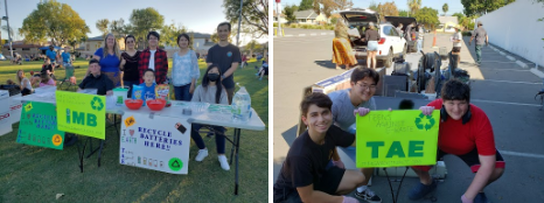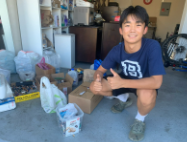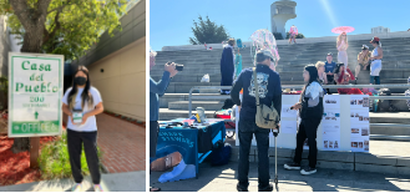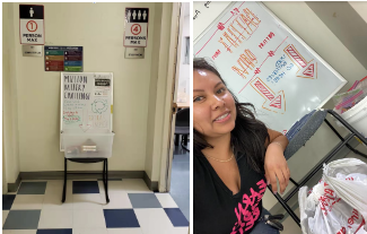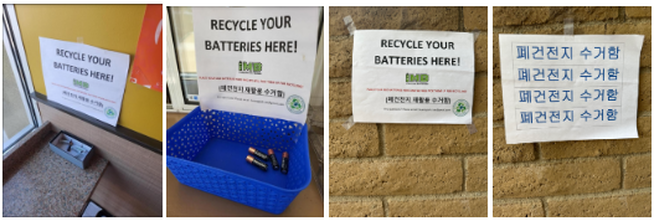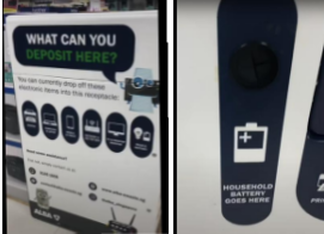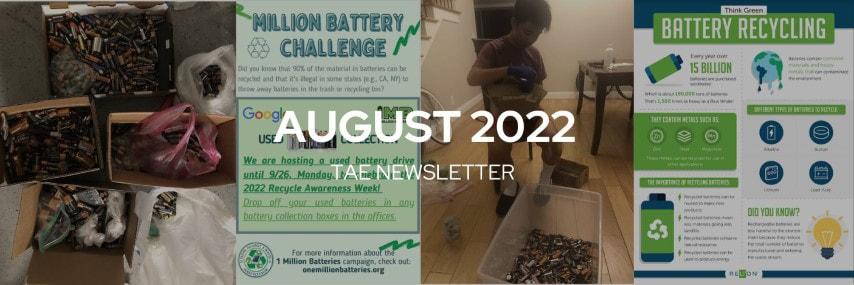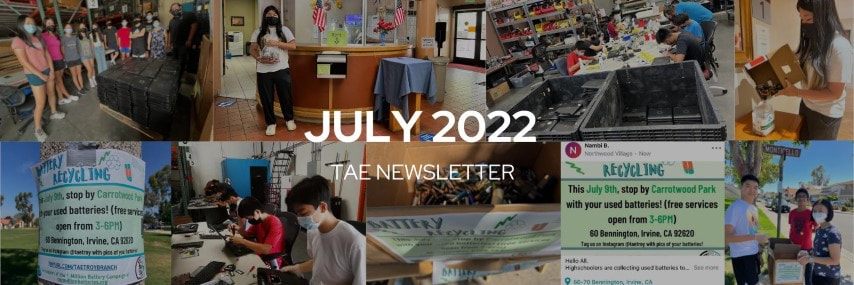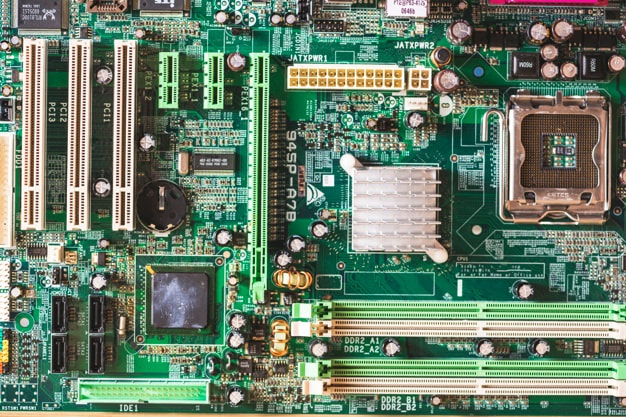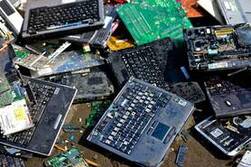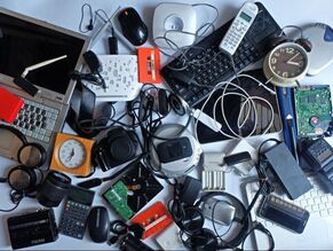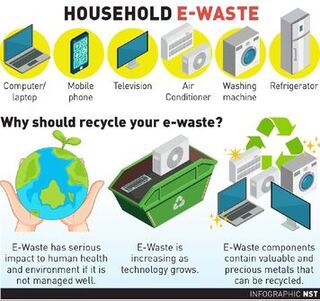1) Here is the story from Jaqueline Zhou - Troy High BranchSeptember was a fruitful month for the TAE Troy Branch. With the school year starting soon, we began a campaign to inspire many of our branch members here at Troy to create their own branches, ultimately resulting in 7 new branches being recruited! In addition, to celebrate Recycle Week (September 18-24), we got our branch set up as a club at Troy and recruited many fresh new members (over 55 students put their names down on our sign-up sheets) at a school-wide club fair. This was accomplished with many social media posts, such as through Instagram (our handle is @taetroy!) and posting on our school’s Discord student server. With our club officially established, we began planning our first club meeting. We also introduced a new tradition: cookies for batteries! Anyone who brought 20 or more batteries to the club meeting received a cookie. We’re looking forward to hosting more battery and e-waste collections, as well as developing a stronger TAE team here at Troy! 2) Here is the story from Kevin Waldman - Cambridge VA BranchOur branch has participated in many Teens Against E-Waste collection activities, including hosting a school drive with a drive-by class party, co-hosting a district-wide Open House battery drive, and co-hosting college campus events to celebrate Recycle Awareness Week. We have also worked with other TAE branches to run battery collections at the weekly Concert in the Park each Saturday during the past summer, where the community donated their batteries while they listened to music. We also hosted the final community drive at the City's Civic Expo as part of the National Night Out. 3) Here is the story from Joshua Lou - Oxford Academy BranchTo celebrate 2022 International Recycle Awareness Week, TAE Oxford Academy Branch and Cambridge VA Branch co-hosted two events with college students from the Environmental Club of Cerritos College. We organized a three-week battery recycling event from September 6th until 23rd, followed by a free e-waste collection event on September 24th, Saturday, 10am-2pm. Volunteers from Acaciawood Branch and Troy High Branch also came to help. Together, we collected 20,000+ batteries and 10,000+ pounds of other e-waste! We were exhausted after hours of work, especially when temperatures reached over 90°F, but it was well-rewarding to see community members' enthusiastic responses to recycling e-waste and protecting our environment. The Press-Telegram advertised our event, and the Cerritos College Press Release reported the results. 4) Here is the story from Sophie Saibi - SVINTL BranchFor the TAE global events during International Recycle Week, TAE SVINTL Branch reached out to Warburton Place Senior Center in Santa Clara. We met the activities coordinator, Dee, and collected 159 batteries on the first day. We left a collection box there and will continue working with them! 5) Here is the story from Kevin Li - Bellarmine BranchWe reached out to the president of Penitencia Neighborhood Association and successfully established a partnership with them. We then did a battery collection around the Panitencia neighborhood during the International Recycle Week and collected over 1000 batteries. 6) Here is the story from Caroline Wang - Lynbrook BranchWe continued collecting lots of batteries from a few senior apartments. We participated in the ocean protection event “Sharks and Mermaid parade” in San Francisco and advocated TAE at the event. 7) Here is the story from Juniper Jones - Canyon Springs STEM Academy BranchThis month was an exciting month for the Canyon Springs STEM Academy Branch! We teamed up with Cerritos College students and asked them to collect and drop off their batteries at specific locations across the Cerritos College campus. One student (pictured above with permission) collected 1126 batteries! She reported that it was a very heavy load. What a win-win for the student and the environment! 8) Here is the story from Ayden Kim - Beatty BranchI have gone to my parents' shops and placed posters with boxes. In Korean it says collecting batteries. I have also been putting posters on the streets to ask people to recycle their batteries in the provided boxes. 9) Here is a video from Hongyi Lu - Raffles Institution Branch, SingaporeI took this video in a shopping mall called Junction 8 in Singapore. The E-waste bin is in a large electronics appliances shop. Bins like the one in my video can be found in more than 300 locations all around Singapore. https://www.youtube.com/channel/UCd58mtoLE7B-jk5oEM7Yo2g - Follow this link to watch Hongyi’s video and other videos in the TAE YouTube channel.
Stories written by multiple TAE branches. Formatted into a blog post by the Communications Committee. Tags:
In 2018, Canada’s households reported almost 11 million tons of incinerated and trashed waste – which averages 725kg per household. Despite this extravagant number, only 1% of this amount was diverted from landfills that year. When looking at electronic waste specifically, the numbers aren’t much better: only 38% of dead electronics avoid the landfill in Ontario. Given that Ontario is one of the few provinces across Canada that has implemented recycling regulations, why isn’t this number lower?
The answer to this question lies in Canada’s current treatment towards e-waste. A Statistics Canada survey compares different recycling methods taken by households that had e-waste to dispose of in 2017 and 2019. Of those 6 results, sending the waste to a depot center is still the most frequented option of disposal in both years, averaging a 4.5% increase across electronics, with the most disposed products being monitors, printers, and AV equipment at 65% in 2019. It’s great news that households are becoming more aware of proper disposal methods, but there is still a long way to go before this number can truly be called efficient. While recycling is one of the primary ways to diminish the environmental damage that e-waste brings, looking at ways to reduce waste is more effective, as it tackles the problem at its base rather than dealing with its side effects. The second most popular option for these households was to continue holding onto them – this averaged 21% of the households in 2019. This is quite a large percentage of electronic waste, which the Ontario government recognizes as something to improve upon. Effective January of 2021, the government introduced a regulation in 2020 that holds producers financially responsible for their products’ waste. The Resource Productivity and Recovery Authority (RPRA) is tasked with monitoring producers to ensure their continuous cooperation, which will force producers to take a greater part in reducing costs and educating consumers. A prime example of this encouraged corporate responsibility is Nokia. The company plans to collaborate with small business Greener Acres Inc. to use recycled electronic waste to produce and distribute smart poles of high speed internet across the province – starting from 2019, this is predicted to nearly halve energy usage across Nokia products. There’s been no update on this project since then, but we remain hopeful that this plan comes to fruition. This innovation is highly encouraged by Ontario’s new policy, which not only incentivizes consumers to send their old electronics towards a useful cause but also begins reducing the amount of e-waste in the market. This is just the first step of many in the right direction of e-waste management and hopefully, into a future of zero waste in Canada. Written by Grace Gan, Ontario, Canada Tags:
A few country examples are described below, to provide you a sense about how you may need to conduct a bit of research locally before you know how you can help recycle batteries. US In the US, only one state, California, requires all alkaline batteries to be recycled. In other US states, individuals can purchase battery recycling kits used to ship batteries to recyclers. Some stores such as IKEA also collect alkaline batteries for recycling. However, some chain stores which advertise battery recycling (such as Best Buy) often only accept rechargeable batteries. In the US, at Earth911 Recycling Search, type in “Batteries” and your zip code, a list of drop-off locations and types of batteries they accept can be found. Canada Among Canada’s ten provinces and three territories, only four provinces (British Columbia, Ontario, Quebec and Manitoba) have battery stewardship and recycling regulation. For example, in Ontario, starting in July 2020, it is battery producers’ responsibility for collecting and reusing, refurbishing or recycling their batteries when consumers discard them. The required collection rate was set at 40% for 2020, which will increase over time to 50% for 2025. Producers will pay service providers (including haulers, refurbishers, processors and general contractors such as Call2Recycle) to fulfill their responsibility of recycling batteries. Free battery drop-off locations are widely available in Ontario, such as in libraries, pharmacies, hardware and electronic stores. In Canada, at Call2Recycle Locator, type in your zip code, and there will be a list of drop-off locations identified in your neighborhood. European Union (27 countries) In the past, used batteries ended up at landfill sites. In 2006, the EU Battery Directive regulated the manufacturing and disposal of batteries and accumulators in the EU to protect human health and the environment from hazardous substances. The EU Battery Directive requires producers to properly label their battery products. They must finance collection and recycling programs, as well as public awareness campaigns for battery waste disposal. In addition, they may not charge a fee for separate collection at the time of disposal. Learn more: https://www.epa.gov/recycle/used-household-batteries https://www.call2recycle.ca https://rpra.ca/programs/batteries/ https://ec.europa.eu/environment/topics/waste-and-recycling/batteries-and-accumulators_en Written by Amelia Halverson, Ontario, Canada Tags:
Over the period of 2020 to 2021, there has been a rapid increase in the number of people who watch/purchase TVs, especially due to the massive global pandemic and most people having to isolate themselves at home. Though TVs have brought us a lot of entertainment this past year, electronics companies have been hiding a big secret that may be more dangerous than you think. For decades, television producers have been putting toxic organohalogen flame retardant chemicals (OFRs) into their products, encased in plastic casings. These televisions are sold at major U.S. retailers like Best Buy and Amazon. Because of this, a lot of our TVs are part of a large; and growing, source of toxic pollutants in our homes, environment, and workplaces. To add more salt to the wound, they pose serious health threats. When you dispose/recycle televisions that contain OFRs, they can potentially release dioxins which are among the most toxic chemicals known to science. Workers and people who live in the vicinity can breathe in these harmful chemicals and face medical problems. Household fires can also release these chemicals, which has led to firefighters supporting the efforts to ban flame retardants. Though the situation may seem unchangeable, there is still hope. Best Buy; a major electronics company, has launched a chemicals policy with the goal to reduce the use of chemicals. They are heading in the right direction, even if there are still a lot of things to improve on in their policies. Let's just hope that more companies hop on the bandwagon! Learn more: https://saferchemicals.org/2020/05/20/toxic-tvs-best-buys-step-in-the-right-direction-should-go-further/ Written by Amelia Halverson, Ontario, Canada
Tags:
Imagine breaking one piece of an electronic device, for example a battery, and having to buy a completely new one just because you just couldn't replace one item. This happens with anything from phones to cars, and we sadly can't do much about it. Not only is it an inconvenience for the consumer, it also increases e-waste by getting rid of perfectly good electronics. Since products are getting progressively harder to repair, Right to Repair movements have been pushing for repair tools. Now, what is the "Right to Repair"? In a couple words, it is the general right for a customer to be able to repair their own electronics/products that they have purchased and rightfully owned. Though this applies to all products, and you can technically fix them, companies try their best to make it as hard as possible to fix their products. Therefore they make you buy a brand new version of the products that broke. One of the companies that did this was Apple, an incredibly successful electronics company. They have very rare materials/parts that are very specific to, for example, iPhones, so that it would be very hard for customers to fix their iPhone alone.Though this is horrible, especially for the e-waste crisis, it appears that Apple may be changing their ways. Just a couple weeks ago Apple released a “Self Service Repair program” that will help customers perform their own repairs from the comfort of their own homes. Next year, they will start selling pieces and repair tools for the iPhone 12 and iPhone 13 in the United States, and then expand to more countries over 2022. This will enable customers to fix their products without having to waste a (almost) completely functional item. Since Apple is such a huge company, this could be a big help with e-waste because there would be a lot less wasting of good electronics. Though Apple still recommends visiting a professional Apple repair shop (which is super expensive), this new Self Service Repair program might just help with the prevention of e-waste, and give customers a bit less reliant on the brand. Learn more: https://www.repair.org/stand-up https://www.theverge.com/2021/11/19/22787245/apple-iphone-mac-self-service-program-repair-diy Written by Amelia Halverson, Ontario, Canada
Tags:
Everyone needed something that was portable, effective, and very easy to use. The perfect candidate was the laptop! Now they have become a key part of life and work, and are used almost everywhere. This video was even made on a laptop. Though they may be the saviors of our sanity in these past years, they have a flaw; they are incredibly hard to recycle. The problem is, modern laptops are made of many different materials that are incredibly hard to disassemble. These include different types of plastic, thin batteries, and LED light strips. though it is a huge challenge. Secondly, it helps to reduce the amount of laptops sent to landfills. Even if people might be aware of the benefits to recycling laptops, they decide not to for various reasons. One main reason for this is that data does not simply disappear from your laptop because you recycle it. This means that if you don’t wipe your device, there is a risk of identity theft. Identify theft is when someone steals another person’s personal information and uses it for their own benefit, for example, stealing money from their bank account. This is a very serious problem, and one that could lead to a lot of bad things for the victim. Because of this data problem, many people are reluctant to recycle their laptops, meaning that most laptops end up in a box in people’s basements or worse, in the landfill. We need to do something about this problem, or else the e-waste will get worse and worse. Written by Amelia Halverson, Ontario, Canada The Problems with Laptops During COVID-19
Produced by Amelia Halverson Tags:
Written by Joshua Lou, California, USA
Tags:
|
Categories
All
Post Time
September 2023
|


